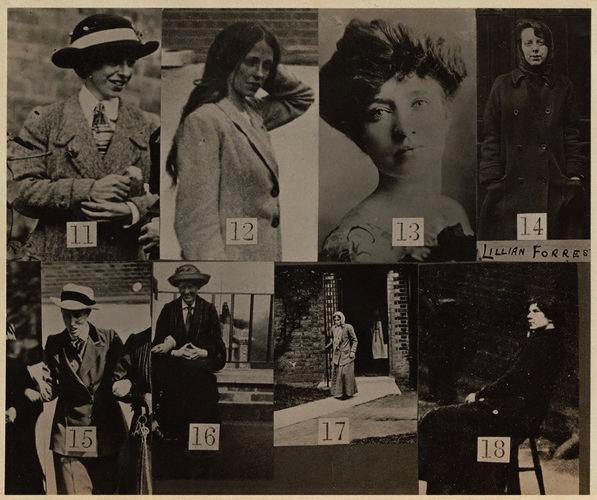Militant suffragette Lilian Ida Lenton, AKA Ida Inkley, is labelled “12” in the Criminal Record Office surveillance photo above.
Lenton (1891-1972) was a dancer who joined the WSPU at age 21. She was introduced to militant action as part of 1912 campaign to attack pillar boxes, which is likely where her alias was derived from.
Her commitment to militancy quickly escalated. She was arrested in March 1912 for participating in the WSPU window smashing campaign. She recieved 2 months in prison, which she served as Ida Inkley.
Lenton developed into a notorious WSPU terrorist. She became a press sensation in 1913 when, following her arrest for setting fire to the tea pavilion in Kew Gardens, she developed pleurisy due to force feeding.
During subsequent prison sentences, she again went on hunger and thirst strikes, and was released and re-arrested under the “Cat and Mouse” Act. Lenton prided herself on her ability to evade arrest, which earned her a second nickname, the Tiny Pimpernel.
In the clip below, Lenton discussed the Cat and Mouse Act that she became well aquainted with in 1913-14.
Lilian Ida Lenton talks about The Cat and Mouse Act, BBC Interview, 1960
Lenton is of interest to “Cycling to Suffrage” due to the unusual circumstances surrounding one of her many arrests. In 1913, after publicly declaring her intent to burn two building per week as part of the militant campaign, Lenton rose to the top of the police wanted list. She was arrested in October of that year while collecting her bicycle from left luggage at Paddington Station.
Sources:
Image: “Surveillance Photograph of Militant Suffragettes,” Criminal Record Office, silver print, The National Portrait Gallery, NPGx132847, 1913.
Elizabeth Crawford, The Suffragette Movement, (London & New York: Routledge, 1999) p 431.








